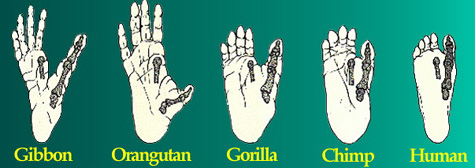
The Physical Characteristics of Humans
- Page 5 -

The feet of living ape species are essentially adapted to life in the trees and feature a big toe capable, like the primate thumb, of grasping objects such as tree limbs. In sharp contrast, the hominid/human foot above, far right, is adapted to bi-pedal locomotion and has largely lost its grasping ability. The big toe lies flat alongside the other toes and provides a flexible platform for walking and running. Other adaptations of the foot include an extended heel, for balance, and complex arches. The foot allows the full use of our physical powers in erect walking and running, and thus frees our hands for a multitude of tasks.
The hominid/human foot is an engineering marvel, capable of absorbing shocks and stresses of approximately 6,000 pounds during an activity like pole vaulting or jumping. Because foot bones are seldom preserved in the fossil record, we cannot pinpoint the time at which the hominid/ human foot evolved. A set of human-like footprints preserved in volcanic ash and dating to 3.5 million years was found in 1978 at Laetoli in northern Tanzania, so our distinctive foot is at least that old. Of course erect walking without such an effectively adapted foot would make a hominid an easy meal for a predator, so it is reasonable to assume that erect walking and an efficient foot like our own evolved together. Recent discoveries of H. habilis hands and feet show that they are virtually identical to our own, though 2 million years old.